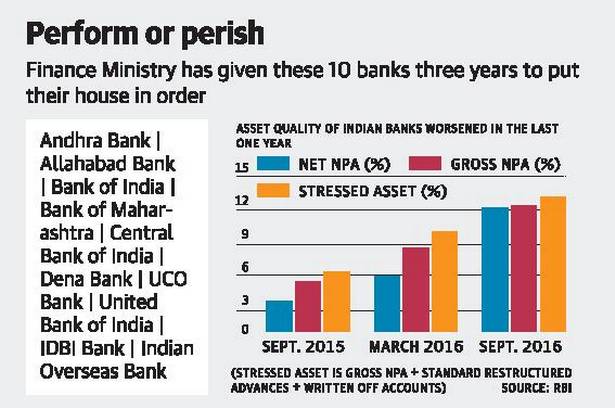Why in news?
The Finance Ministry has written to 10 public sector banks, making it clear that the lenders would only get further capital infusion once they submit a time-bound turnaround plan.
What is the reason behind such a move?
- The government’s move to crack the whip on lenders comes after some banks reported losses in financial year 2015-16 as well as for the nine-month period of the current financial year.
- Bad loans zoomed following the RBI’s asset quality review, which required banks to classify many accounts identified by the banking regulator as ‘bad’.
- The government wants 10 public sector banks to turn around in the next three years.
- The Centre, which has mandated SBI’s merchant banking arm SBI Caps to examine each bank’s plan, wrote to the state-owned lenders last week stipulating that they would each have to sign a Memorandum of Understanding (MoU) with the government, agreeing to stick to the turnaround plan.
- Interestingly, for the first time, the employees’ unions have been made a party to the proposed agreement.

What is the response from RBI?
- The RBI said it wanted to clean up banks’ balance sheets by March 2017.
- In its financial stability report, RBI had said banks may remain risk averse in the near future as they clean up their balance sheets and their capital position may remain insufficient to support higher credit growth.
- According to RBI data, gross non-performing assets of commercial banks increased to 9.1% of their gross advances as of September 2016, from 5.1% a year earlier.
- Public sector banks share a disproportionate burden of this stress.
What were the earlier measures to revamp banks?
- In 2015, under the Indradhanush plan, the government had announced capital infusion of Rs 70,000 crore in public sector banks for four years, starting from 2015-16.
- In the first two financial years, Rs 25,000 crore had been earmarked per year with Rs 10,000 crore to be disbursed in each of the remaining two years.
- Credit rating agencies had pointed out that the sum was insufficient as banks needed to meet Basel-III norms as well as make provisions for rising bad loans.
Source: The Hindu
